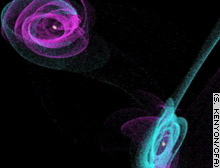This evaluation comes mainly due to an attempt to understand the special course of a workshop

According to astronomers, the shape of the solar system may have been influenced by a close encounter with another star. The dramatic encounter, if it occurred, may also have introduced alien objects into the solar system. This action can be compared to a collision between two electric saws buzzing against each other and flying sparks.
The above theory was proposed to explain several incomprehensible phenomena in our solar system. According to the above theory, the encounter took place shortly after the birth of the solar system. About 4.5 billion years ago.
According to astronomer Scott Kenyon from the Smithsonian Astrophysical Observatory, there is a possibility that several objects in our solar system actually formed around another star.
There is no solid evidence that the sun was previously in a close interaction with another star, but many astronomers speculate that the sun was formed in a cloud of gas along with several other stars, as is typical of many stars in the galaxy. The sun was later released from the cloud.
According to the estimates of scientists in the past, during the "chaotic" event where stars, comets and asteroids took their shape and orbit, it seems logical that the Sun is significantly closer to another planet.
Several studies even suggested that such an interaction even affected the shape of the solar system.
The new computer models show that young objects in a circular orbit around the Sun were carried into distant and elongated orbits due to proximity to another star. Objects in these orbits cannot yet be distinguished using the existing technology.
Such an interaction could have caused the distinct sharp discontinuity at the outer edge of the Kuiper belt - a region of icy objects beyond "Neptune".
One of the main motivations for examining the model was the discovery of "Sadana" located far beyond "Pluto" last year.
The size of "Sedna" is at least half the size of "Pluto" and has an elongated orbit that is completely outside the "Kuiper belt".
Astronomers do not yet know how "Sadana" got its trajectory, but it is assumed that other similar objects are waiting to be discovered.
Kenyon together with his partner Benjamin Bromley, from the University of Utah, estimated that the "almost collision" occurred when the solar system was 30 to 200 million years old.
The gravity of the passing star swept objects from the outer part of the solar system, but in the interaction objects also moved into the solar system.
According to Bromley, the current explanation provides a solution to two mysteries - it explains the orbit of "Sedna" and the configuration of the outer part of the "Kuiffer Belt".
According to Mike Brown, the astronomer who led the team that discovered "Sadana", the new study gives an explanation that is one of the possibilities that must be examined in order to understand the trajectory of "Sadana". Another possibility is that "Sadana" may have been pushed into its orbit by an object the size of a DA that is no longer in the "Kuiper Belt". The difficulty in determining the real reason was that currently only the trajectory of a single object is relied upon.
